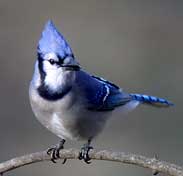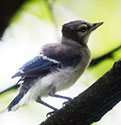 I would sure like to know what the blue jays are saying to each other. This morning two groups of seven or eight blue jays stood in close clusters on bare tree branches, doing a sort of dance.
I would sure like to know what the blue jays are saying to each other. This morning two groups of seven or eight blue jays stood in close clusters on bare tree branches, doing a sort of dance.
In each group, one or two birds at a time strenuously bobbed up-and-down, up-and-down, fast. As if they were doing deep-knee-bends. At the same they were stretching and scrunching their necks.
This made their heads go up and down like bouncing balls. At the high point of each repetition, the jay made a clear musical note, like the toll of a bell. Then one bird would stop the bobbing and tolling, and another would take it up. They seemed excited.
I felt as if I were watching a foreign film without the subtitles: I could sense the emotion of the actors, and it all looked extremely interesting, but I simply couldn't tell what they were going on about.
I need a dictionary of jay talk.
Besides ringing like bells, blue jays screech, whistle, whisper, croak, rattle, and sing queedle-queedle-queedle. They pose, peck, quiver, raise and lower their crests, and flash meaningful looks at each other.
They're communicating, all right, but I can only guess at what they mean. Still, sometimes I can catch the drift.
Jays harrassing owls
I think I know how blue jays feel about owls. Despise them! Owls prey on birds at night, and blue jays recognize them as enemies. Any time that jays discover an owl in daylight, they harass it.
 If you're ever walking in woods and you hear a bunch of blue jays screaming, follow that sound. Look for the flock boiling up out of a tree, diving into the branches and bounding into the air. Then try to locate the focus of their attention.
If you're ever walking in woods and you hear a bunch of blue jays screaming, follow that sound. Look for the flock boiling up out of a tree, diving into the branches and bounding into the air. Then try to locate the focus of their attention.
You will probably find an owl. Usually it's a great horned owl. Its eyes are shut, as if it's asleep or bored or unaware of the blue jays that swoop down within inches of it.
Sometimes a jay will actually peck the top of the owl's head. It looks as if they're enjoying themselves.
The victim may endure such attacks for a long time, but eventually it's had enough. It silently wings off through the trees, a streamer of bellowing blue jays trailing behind it. The jays follow the owl until they drive it well out of their territory, and then they return, to whoop and screech at one another for a while until they cool down, like a bunch of kids who've just won a tournament.
From watching blue jays mob owls, I've come to understand that bit of blue jay talk. In fact it helps me to find owls myself.
Cat alarm
I also know the blue jay's cat alarm. I learned it one day while observing a fledgling blue jay. The baby had just left its nest and found itself on our lawn. Barely able to fly, it was scrabbling across the grass toward the tangle of red osier dogwoods that bordered our yard. I was standing guard, to make sure it got to shelter safely.
Suddenly, the loud screech of a blue jay rang out, from across the street. I saw a yellow cat trotting toward my yard, while an adult blue jay swooped back and forth above it, screeching loudly.
Now, I'm not suggesting that the bird spoke English, but the funny thing was that it sounded to my ears as if it were screaming CAT! CAT! CAT!
 Instantly the fledgling blue jay struggled into the air and with its little wings beating frantically hurled itself into the dogwood thicket. Quickly it disappeared into the foliage.
Instantly the fledgling blue jay struggled into the air and with its little wings beating frantically hurled itself into the dogwood thicket. Quickly it disappeared into the foliage.
The baby jay did not have a clear line of sight—it could not have seen the cat coming. I don't think I'm going out on a limb to guess that the baby jay understood the meaning of the adult's shrieks.
Today ornithologists are studying the communication of birds. They're trying to learn each species' vocabulary of gesture and sound. For example, we now know that jays announce a cat with a different call from the one they make when a hawk comes around. And based on the kind of call the jays make, other birds respond differently for each kind of threat.
Science has barely scratched the surface of communication between birds. But we can all listen to the sounds that birds make right in our own back yards. Simply noticing the sounds that birds make is the first step toward understanding them.

